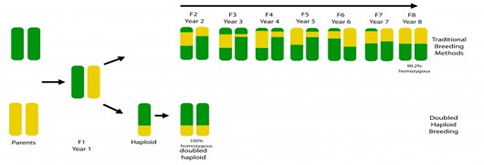Author: Dr. Rakesh Choudhary
SUMMARY
Ø Homozygous lines are of utmost importance in breeding programmes. Androgenesis, Inducer based approach and Bulbosum technique are most common ways to support the development of such valuable DHLs.
Ø Double haploid technology enhances “forward breeding” by allowing hybrids to be bred with new traits without locking up the germplasm and by developing stacks without negative side effects.
Ø Besides the practical facet of this technique, it is a valuable method for genetic cartography of complex traits, transgenesis and genomics among others.
Ø From a breeding point of view, in self pollinated species, such as the small grained cereals, double haploids can be used directly for the production of varieties, since each DH has the potential to become a new variety.
INTRODUCTION
“DOUBLE HAPLOID (DH) - A plant or line obtained by doubling the chromosome number of a haploid plant or individual”.
The genetic upgradation of crops through conventional breeding approaches require longer time so there is a need to assist these methods following certain biotechnological tools to shorten the breeding cycle and DH breeding is one such tool which has been widely used in crop improvement programmes. Double haploid technique is a valuable method for genetic cartography of complex traits, transgenesis and genomics.
In order to obtain a DH, two main steps should be usually considered:-
(i) Induction of haploid and
(ii) Doubling of chromosomes of the haploid individual.
Double haploid methodologies have now been applied to over 250 plant species.
DIFFERENT METHODS FOR DOUBLE HAPLOID PRODUCTION
In vivo methods
1. Extensive hybridization crosses followed by chromosome elimination
2. Bulbosum Technique eg. Hordeum bulbosum x Hordeum vulgare
3. Parthenogenesis- (i) Pseudogamy (ii) Semigamy (iii) Apogamy
4. Inducer based approach eg. Mainze
In vitro methods
1. Androgenesis 2. Gynogenesis
APPLICATIONS OF DH IN PLANT BREEDING
• Development of homozygous inbred line and cultivars
• Giving an immediate product of stable recombinants from species crosses or fixation of heterotic combination
• No masking effects because of high homogenity
• High efficiency in stacking specific targeted genes in homozygous line
• Increased performance per se due to selection pressure in the haploid phase or during first generation of DHs
• Simplified logistics for seed exchange b/w main and off season programmes since each line is fixed and can be represented by a single plant
• Development of substitution and addition lines
DOUBLE HAPLOID BREEDING SCHEME

About Author / Additional Info:
Dept. of Genetics and Plant Breeding, G.B. Pant University of Agriculture & Technology, Pantnagar (Uttarakhand)